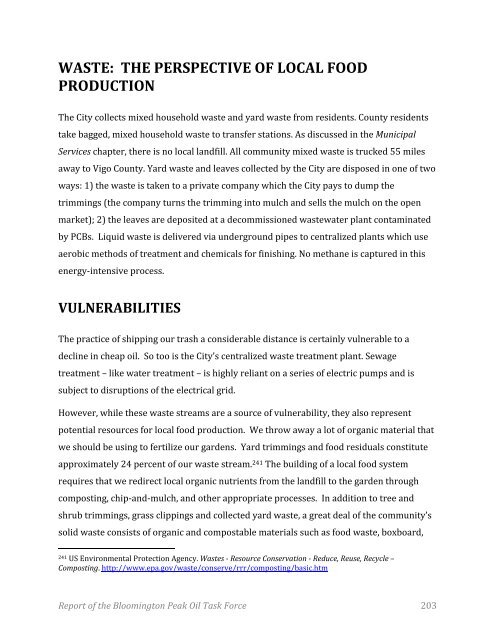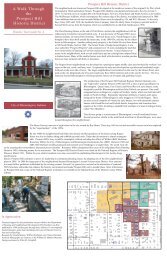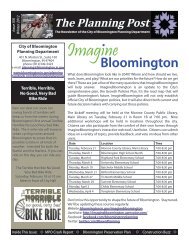Peak Oil Task Force Report - City of Bloomington - State of Indiana
Peak Oil Task Force Report - City of Bloomington - State of Indiana
Peak Oil Task Force Report - City of Bloomington - State of Indiana
You also want an ePaper? Increase the reach of your titles
YUMPU automatically turns print PDFs into web optimized ePapers that Google loves.
WASTE: THE PERSPECTIVE OF LOCAL FOOD<br />
PRODUCTION<br />
The <strong>City</strong> collects mixed household waste and yard waste from residents. County residents<br />
take bagged, mixed household waste to transfer stations. As discussed in the Municipal<br />
Services chapter, there is no local landfill. All community mixed waste is trucked 55 miles<br />
away to Vigo County. Yard waste and leaves collected by the <strong>City</strong> are disposed in one <strong>of</strong> two<br />
ways: 1) the waste is taken to a private company which the <strong>City</strong> pays to dump the<br />
trimmings (the company turns the trimming into mulch and sells the mulch on the open<br />
market); 2) the leaves are deposited at a decommissioned wastewater plant contaminated<br />
by PCBs. Liquid waste is delivered via underground pipes to centralized plants which use<br />
aerobic methods <strong>of</strong> treatment and chemicals for finishing. No methane is captured in this<br />
energy‐intensive process.<br />
VULNERABILITIES<br />
The practice <strong>of</strong> shipping our trash a considerable distance is certainly vulnerable to a<br />
decline in cheap oil. So too is the <strong>City</strong>’s centralized waste treatment plant. Sewage<br />
treatment – like water treatment – is highly reliant on a series <strong>of</strong> electric pumps and is<br />
subject to disruptions <strong>of</strong> the electrical grid.<br />
However, while these waste streams are a source <strong>of</strong> vulnerability, they also represent<br />
potential resources for local food production. We throw away a lot <strong>of</strong> organic material that<br />
we should be using to fertilize our gardens. Yard trimmings and food residuals constitute<br />
approximately 24 percent <strong>of</strong> our waste stream. 241 The building <strong>of</strong> a local food system<br />
requires that we redirect local organic nutrients from the landfill to the garden through<br />
composting, chip‐and‐mulch, and other appropriate processes. In addition to tree and<br />
shrub trimmings, grass clippings and collected yard waste, a great deal <strong>of</strong> the community’s<br />
solid waste consists <strong>of</strong> organic and compostable materials such as food waste, boxboard,<br />
241 US Environmental Protection Agency. Wastes Resource Conservation Reduce, Reuse, Recycle –<br />
Composting. http://www.epa.gov/waste/conserve/rrr/composting/basic.htm<br />
<strong>Report</strong> <strong>of</strong> the <strong>Bloomington</strong> <strong>Peak</strong> <strong>Oil</strong> <strong>Task</strong> <strong>Force</strong> 203









